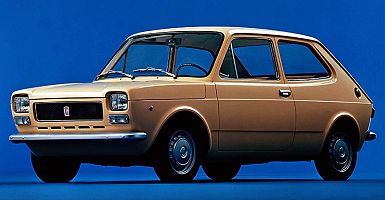Initially launched in 2 door form only, a 3 door
variant (the boot becoming a hatch, and the rear seat becoming a folding piece) arrived the following year. These first series cars were built from
1971 to 1977 and were only available with the one engine (903cc) and two
trim levels (excluding special editions).
The new 127 was one of the first of the now commonly known 'Supermini' cars, and was praised for its space utilisation (80% of the floor space
was available for passengers and luggage) and its safety, with a deformable structure designed to minimise the effect of an accident, a collapsible
steering column and other design features. The modern design, relatively good performance (for its segment) and excellent roadholding made it
the best selling car in Europe for several years.
In 1977 the new series II car was introduced,
which had a redesigned front end, lights, grille, bumpers, etc.... It also
introduced a new 1049cc engine, produced in Brazil, which was sold alongside
the older 903cc engine. Three levels of trim became available, the 'L',
'C' and 'CL'. A new 127 Sport joined the range in 1978 with the 1049cc
engine tuned to give 70bhp (modified valves, manifolds, carburettor), improved
brakes, a larger anti-roll bar and a variety of modifications to the trim,
both outside (bumpers, grille, mirror) and inside (seats). 1979 saw the
arrival of the 'Top' which was a three door 1050cc car with a full length
canvas sunroof and wider tyres as standard. The same year saw the arrival of the 'Rustica'.
Developed from the Brazilian 147, this had a strengthened shell with a
A five door 127, the 'C' arrived in 1980
powered by the 903cc engine (originally developed by SEAT in Spain as a four door) and shortly afterwards, in November 1980, the
'Panorama' was released. This was an estate variant based again on the Brazilian 147, with a raft of mechanical
modifications including the cooling system, brakes, transmission and fuel
tank. The following year the 127 diesel was released, powered by a 1301cc
diesel engine, derived from the 1050cc unit, with 45bhp. The same engine
was also available in the Panorama.
In March 1981 the whole range received
a variety of small changes, and the trim levels were revised and renamed
'Super', 'Special' and 'Sport'. November of the same year ,1981, saw the
final, series III, facelift which brought again new lights and grille as
well as new bumpers. A new engine also appeared in the 'Sport', now a 1301cc
unit with 75bhp. The final update appeared in 1983 when the diesel saloon
and Panorama versions received an external facelift plus a variety of small
technical improvements. Production ceased in 1987.
The following summarises the models produced :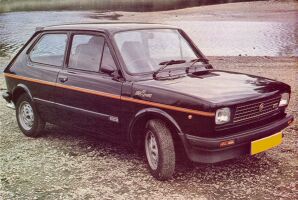 Introduced
in April 1971 to replace the 850, the 127 was awarded the higest European press accolade,
'Car of the Year', in the same year. A significant change from its rear-engined predecessor, it adopted the 'new' front-wheel drive
layout as used in the 128. Indeed most of the
mechanical components and layout were based on the latter car, with a similar braking (front discs, rear drums) and suspension (front MacPherson, rear
independent with transverse leaf spring) setup. The only powerplant available at launch was a 903cc engine derived from that
of the 850 Sport.
Introduced
in April 1971 to replace the 850, the 127 was awarded the higest European press accolade,
'Car of the Year', in the same year. A significant change from its rear-engined predecessor, it adopted the 'new' front-wheel drive
layout as used in the 128. Indeed most of the
mechanical components and layout were based on the latter car, with a similar braking (front discs, rear drums) and suspension (front MacPherson, rear
independent with transverse leaf spring) setup. The only powerplant available at launch was a 903cc engine derived from that
of the 850 Sport.
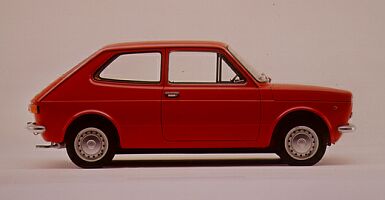 variety of modifications for 'rough road' work including stronger suspension, modified brakes, different gearbox ratios etc.
Only available in beige, the interior was much simplified, side rubbing strips came as standard and wire mesh headlight guards were fitted.
variety of modifications for 'rough road' work including stronger suspension, modified brakes, different gearbox ratios etc.
Only available in beige, the interior was much simplified, side rubbing strips came as standard and wire mesh headlight guards were fitted.
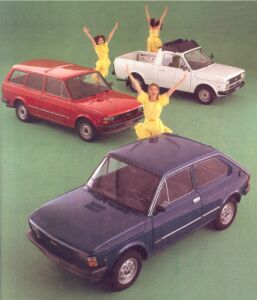 Series
I, from 1971 :
Series
I, from 1971 :
2dr, 3dr 903cc (47bhp)
Special 903cc (45bhp)
Series II, from 1977 :
2dr, 3dr, Top, Rustica, Panorama, Super 1049cc (50bhp)
Sport 1049cc (70bhp)
'C' 5dr 903cc (45bhp)
Diesel 1301cc (45bhp)
Series III, from1981 :
Special 903cc
Super 1050cc
Sport 1301cc (75bhp)
Diesel 1301cc (45bhp)
Italian production totalled 3 779 086 examples (in Spain (SEAT) 238 166)
For details of the Fiat 147, the
127 built in South America, click here. A total of 169,312 of this version was produced.
See a period promotional video of the 127 (2.3MB)
Technical Details
| Driveline | transverse engine at front with front wheel drive |
| Engines | 903cc (65x68mm) ohv 4 cyl with 47bhp @ 6,200rpm
from 1974 with 45bhp @ 5,600rpm (reduction due to improved emissions) 1049cc (76x57.8mm) ohc 4 cyl with 50bhp @ 5,600rpm with 70bhp @ 6,500rpm in the 'Sport' from 1978 1301cc diesel (76.1x71.5mm) sohc 4 cyl with 45bhp @ 5,000rpm 1301cc (76.1x71.5mm) sohc 4 cyl with 75bhp @ 5,750rpm in the 'Sport' from 1981 |
| Fuel Consumption | 1977 '900'
Simulated urban cycle 33.6mpg / 8.4 l/100km Constant 56mph 48.7mpg / 5.8 l/100km 1978 '1050' Simulated urban cycle 34.7mpg / 8.9 l/100km Constant 56mph 42.8mpg / 6.6 l/100km 1978 'Sport' Simulated urban cycle 27.9mpg / 10.1 l/100km Constant 56mph 39.2mpg / 7.2 l/100km |
| Suspension | front : MacPherson strut with telescopic dampers and coil springs plus anti-roll bar
rear : independent with telescopic dampers and single, transverse leaf spring wheelbase : 2225mm track (front/rear) : 1280mm/1295mm (Sport : 1288mm/1303mm)(Diesel ; 1270mm/1300mm) |
| Brakes | front : discs. diameter 227mm
rear : drums, diameter 185mm front calliper piston diameter : 48mm rear wheel cylinder bore : 19.05mm handbrake operating on the rear via a cable |
| Gearbox | 4 and 5 speed manual
cable operated clutch disc diameter : 160mm, later 170mm |
| Steering | Rack and pinion
3.5 turns lock to lock |
| Kerb weight | series I (2 door) : 705kg
series II (3 door) : 730kg; Panorama : 830kg series III : 710 to 730kg Diesel 835kg |
| Dimensions | Internal & external |
click here for a cutaway drawing of the 127
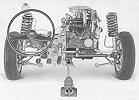 |
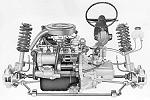 |
 |
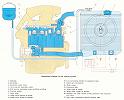 |
Performance
| model | max speed | 0-100 km/h | standing km | Braking (from 100km/h) |
| 127 Sport (1978) | 155 km/h | 12.9 sec | 34.5 sec | |
| 127 Sport (1982) | 164 km/h | 10.0 sec | 32.5 sec | 46.5 m |
| 127 Diesel | 130 km/h | 23.5 sec | 41.3 sec | |
| 127 900 (1982) | 133 km/h | 15.8 sec | 37.9 sec | |
| 127 1050 (1982) | 139 km/h | 14.8 sec | 37.1 sec |
Tuning
There are three main areas to concentrate on, the engine (and transmission), the brakes and the suspension and then various other details. These three should be done together since they complement each other, not all of one and none of another !
1. The engine.
The first improvements are relatively simple.
The air filter can be replaced for an aftermarket item which will help
the engine breathe more freely, the type which completely replace the original
airbox are best, and the exhaust can be replaced for one which will restrict
the exit of the gases less.
The main modification (outside of taking
the engine apart) is to fit a better carburettor. Either a unit from a
larger engined model, or you
can buy a special inlet manifold to allow the fitment of other units. A
camshaft will also provide a noticeable gain, especially if fitted in conjuction
with the carburettor.
Other things to do should include fitting
a cold air intake, a large diameter pipe (minimum 5cm) to provide air from
outside the engine bay to the air filter. The exhaust manifold can also
be lagged with thermal cloth or tape to keep the exhaust gases hotter (and
thus reduce back pressure) and also to keep the underbonnet (and hence
intake and fuel) temperatures lower.
Further modifications require the machining
of the cylinder headand/or cylinder block (which will not be dealt with
here since it is not normally a DIY job) after which it may be worth fitting
an oil cooler. If overheating is a problem due to the increased power output
then a small hole can also be drilled through the plate in the thermostat.
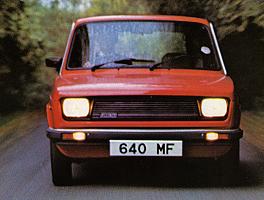 Before modifying the engine it is worthwhile
filling it with a good quality synthetic oil and fitting new spark plugs.
An engine oil additive may also be used.
Before modifying the engine it is worthwhile
filling it with a good quality synthetic oil and fitting new spark plugs.
An engine oil additive may also be used.
The high tension leads can also be replaced with performance ones.
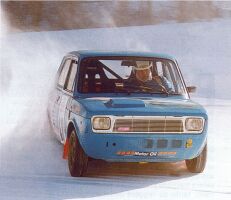 Regarding the transmission the main requirement
is to uprate the clutch to handle the increase in power and torque achieved
though the engine modifications. Friction plates can be purchased with
improved materials and heavier duty pressure plates are also available.
Whilst doing this it is worthwhile lightening the flywheel.
Regarding the transmission the main requirement
is to uprate the clutch to handle the increase in power and torque achieved
though the engine modifications. Friction plates can be purchased with
improved materials and heavier duty pressure plates are also available.
Whilst doing this it is worthwhile lightening the flywheel.
2. The brakes.
Initially it is relatively easy to replace
the brake discs with drilled and grooved items, and the pads for a harder
compound. The latter should not be too hard (ie no race pads on the road)
or they will not function effectively at the normal 'road' operating temperatures.
Stainless steel braided flexible hoses will improve the pedal feel and
reduce the chance of damage whilst DoT5 fluid (not silicon) will increase
the temperature at which it can operate effectively. If the brakes are
getting too hot the dustguards can be removed and/or ducts fitted, taking
air from behind the front bumper.
If more serious braking is required the
next modification would be to increase the disc size. It is possible to
use larger discs with a bracket allowing use of the production callipers,
or alloy four pot callipers can be fitted.
In order to improve the balance of the
car under braking it is desireable to be able to adjust the balance of
braking from front to rear (and vice versa). This can be accomplished by
fitting a bias valve in the line to the rear brakes, usually in a position
so that it can be reached from the drivers seat.
3. The suspension.
The easiest improvement,and the one which
will probably bring the single most noticeable change, is to replace the
dampers and springs. At the front, everything can be replaced, at the rear
the suspension can be lowered by clamping the leaf spring. Top There are then two other main suspension
aims; to reduce the flexiblity in the suspension and to increase the stiffness
of the car, both of which aim at more accurate control of the wheel movement.
To reduce the flexibility it is possible to fit nylon bushes instead of
the normal production rubber items, or if perfection is desired the suspension
can be fitted with metallic bearings (rose joints / rod ends). Spherical
bearing top mounts can also be used. To stiffen the car it is most popular
to fit strut braces. These can be fitted to the front and rear. For more
extreme cases a rollcage can be fitted.....
Into this category also fall the choice
of wheels and tyres. With an increase in power it can be necessary to fit
larger tyres (thus requiring larger wheels) but the temptation to fit the
biggest possible should be resisted. Consideration should be given to fitting
a wider tyre on the front (since they provide traction and steering) but
keeping the standard, or a wider but not as wide as the front, tyre at
the rear. This will improve the balance of the car.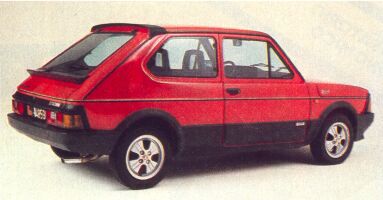 adjustable
dampers are compromised, but are good for road and track day cars since
it allows the suspension to be adjusted between these two, rather different,
requirements. Coil over units add more adjustability and can be purchased
outright, or can be made from standard dampers by welding a threaded sleeve
to the standard tube.
adjustable
dampers are compromised, but are good for road and track day cars since
it allows the suspension to be adjusted between these two, rather different,
requirements. Coil over units add more adjustability and can be purchased
outright, or can be made from standard dampers by welding a threaded sleeve
to the standard tube.
4. other things.
Other modifications worth considering include
fitment of a shift light and rev limiter, higher power bulbs in the headlights
(if you are going to go faster you need to see further) and installation
of a quicker steering rack.
Maintenance
Scheduled maintenance :
Replace air filter : every 10 000km
recommended engine oil : for min temp below -15°C SAE 10W, for min temp below 0°C SAE 20W, for min temp above 0°C SAE 30 and for max temp above 30°C SAE40.
Spark plugs : Champion N7Y or Bosch 215T30, gap 0.5mm to 0.7mm
Buying / Selling
Some tips to do before selling :
(they may seem obvious, but most people don't do them and thus are in a weaker bargaining position)
Tidy inside the car thoroughly : hoover
the floor, empty all pockets, ashtrays (wash), glove compartment etc...,
wipe the trim with a damp cloth, give the cockpit a good airing to get
rid of any odours ! Reset the trip meter to 00000 - it is a pleasant (subconcious) surprise.
If the car has been standing give it a
good run - this will clear out the engine (reduce exhaust smoke), put a
shine on the brake discs and loosen up any joints that may otherwise make some noises.
Jetwash under the car, especially under
the engine and in the wheelarches. The prospective buyer may be an enthusiast,
and this makes it easier for them to see what they want to check.
Obviously wash the car and clean the windows !
If you are going to buy a car always check the following :
127's are now ageing, so firstly check
the bodywork. Pay special attention to the wheelarches (inside if there
is no plastic splash guard), suspension and engine mounts, sill, door pillars
(check for sagging doors), scuttle panel and the floor (doors, bonnet and
boot/hatch are also susceptible, but are more easily replaced). If a sunroof
is fitted check around the edge for signs of rust. Check that there are
no mismatching panels, large areas of discolouration or signs of fresh
paint (compare inside the engine bay with the external body colour), all
of which probably indicate accident damage. Check the amount of play in the door hinges with the door almost closed.
Check for a damp carpet or the presence
of mould - if the carpet is damp then the floor is almost certainly corroded.
Check the main electrical functions - wipers,
lights, etc... try putting the main beam and wipers on at the same time.
Check the headlight reflectors for rust.
Check the brake pedal does not go to the
floor if pressed hard for a long time and check the gearchange for clean engagement.
The engine should be run up to temperature,
check the exhaust for smoke, the condition of the breather (look for mayonnaise),
the Check tyre wear, uneven patterns could imply a bent chassis.
Always take it for a test drive. Check
that the car tracks in a straight line with no steering input and also
remains straight under braking. Find a large open area and complete several
lock to lock turns (also in reverse), listening for any noises. Try the
handbrake when moving - seized rear callipers will mean uneven braking or no braking.
Generally, the 127 is mechanically pretty good, but the bodywork was weak. A Fiat
127 website
Another Fiat 127 website
Another (German) Fiat 127 website
The Czech 127 Fanclub website
Two South American 147 websites
here and
here.
For books on Fiat see our Online Bookstore
There is also a list of all our picture galleries (including museums,
motorshows and various events).
Wallpapers/Desktop
Backgrounds of numerous Fiats also available to download.
127 comment form
Your Comments
It is a very good car, I
think. Mine was bought in 1979, a MK I model. I had replaced the engine
at 593000 Km, quite remarkable mileage indeed. Most of it was done at dirt
tracks at the country. I have to note that even though the engine had lost
power, it had not lost nerve and made the car very lively in the city,
where I live now. The mechanics proved to hold surprisingly well for the
age and mileage and after a recent general rebuilt of the car I have kept
much of the old stuff. I think that although being a small car, the 127
is a car full of soul and nerve and that if you happen to own one in an
average condition, you should preserve it. The replacement parts are cheap
and can be easily found. Just watch out for the rust that is a general
enemy of the italian cars of that age.. Alfa folks share the same emotions,
I know. Nowdays, the 127 is very good at the role of a sports car for one
person (especially for a light person!), most preferrably driven in the
countryside. I must admit that I prefer this car more than today's cars
of the same class. (M, Greece)
I have a really nice Seat-build 127 Special and it is a great car. It has covered 83000 km now and runs
very nice. I have owned it for a year now and this winter has been pretty cold (-20 C), but it always started. This was with old and worn
ignition. Now I have changed the bad parts and it runs better than ever. Its temprament suits my driving style perfectly, and in the city it is
far quicker than new small cars. I only miss a 5th gear and a good hifi in it. Maybe some time in the future. (Lars, Norway)
Use the buttons at the top to navigate further, or
Copyright © 2000 to 2008 CarsfromItaly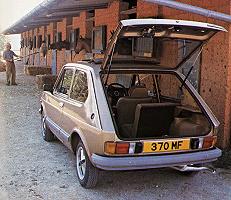 The following data refers to the 1974 903cc model :
The following data refers to the 1974 903cc model :
Check tappet clearances : every 10 000km
Engine oil & filter change : every 10 000km or 12 months
Transmission oil change : every 30 000km
Alternatively 10W/30 for cold (min below 0°C) and 20W/40 for hot climates
All the above oils should be "Low ash content detergent oil meeting the relevant European specification"
recommended transmission oil : SAE 90 non-EP
engine oil capacity (sump & filter) : 3.9 litres
transmission oil capacity : 2.40 litres
Tyre pressures (2-door & 3-door version) front/rear : 1.7bar / 1.9bar
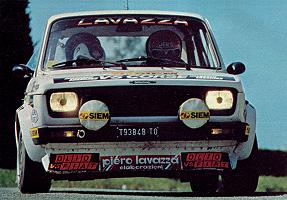
This car, prepared according to the regulations for Group 2, was used in the 1980 Italian rally
championship, prepared by Piero Lavazza of Turin. The 1049cc engine used
different pistons, camshaft, valves, carburettors (44 DCNFs) and produced 109bhp (instead of the standard 50bhp !).
The suspension featured widened tracks, strengthening, rose-joints throughout and special dampers and springs. The brakes
retained the fundamental layout of the road car but with twin master-cylinders and different pads, fluid and hoses. An oil cooler
and a limited-slip differential were also fitted.
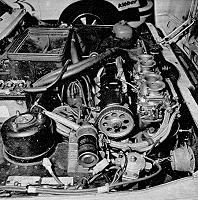
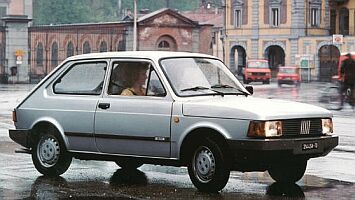 'Back
to black' products are very effective at temporarily restoring bumpers
and trim. This makes a big difference to any car. Do it a week before you
expect people to view the car, otherwise it may be a bit too obvious !
'Back
to black' products are very effective at temporarily restoring bumpers
and trim. This makes a big difference to any car. Do it a week before you
expect people to view the car, otherwise it may be a bit too obvious !
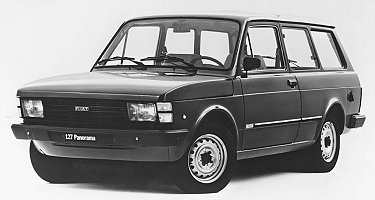 condition
of the oil filler cap (again white deposits can indicate head gasket or
other serious problems or the use of the car only on short journeys, another
bad state of affairs) and the colour of the coolant (preferably not thick
or dark brown!). Listen to the noise of the engine, then depress the clutch
and engage first gear. Whatever noise has disappeared was coming form the
gearbox, what remains is from the engine. Also check the condition of the
engine oil on the dipstick.The lighter brown the better, if it is thick black then leave quickly.
condition
of the oil filler cap (again white deposits can indicate head gasket or
other serious problems or the use of the car only on short journeys, another
bad state of affairs) and the colour of the coolant (preferably not thick
or dark brown!). Listen to the noise of the engine, then depress the clutch
and engage first gear. Whatever noise has disappeared was coming form the
gearbox, what remains is from the engine. Also check the condition of the
engine oil on the dipstick.The lighter brown the better, if it is thick black then leave quickly.
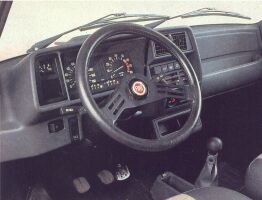 Links
Links
